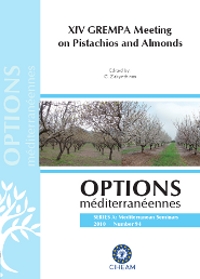| Article précédent | p. 87-94 | Article suivant |
Identification of candidate genes involved in the response to biotic and abiotic stress in almond
Almond is commonly considered as tolerant to diverse biotic or abiotic factors, but little is known concerning the molecular mechanisms involved in the response to stress. In this study we have focused on the search for candidate disease resistance genes (R), and on the isolation of almond homologues to the CBF/DREB1 family of transcription factors, known to play an important role in abiotic stress response. A set of resistance-gene candidate sequences (RGCs) were isolated from one almond cultivar and two wild almond ecotypes (P. webbii). Phylogenetic analysis revealed that RGCs from both cultivar and wild ecotypes, clustered together in 5 different groups. This observation suggested a great similarity of the genetic backgrounds from both species, regarding their biotic resistances. The isolated RGCs are being mapped in the Texas x Earlygold Prunus genetic map. A PCR-based approach was used to isolate almond CBF/DREB1 homologous sequences. Preliminary RT-PCR analysis showed that the isolated almond CBF/DREBs are expressed in cold- and drought-induced tissues. Complete characterization of functional CBFs will provide valuable information regarding the molecular mechanisms involved in drought and cold stress responses in almond.
L'amandier est généralement considéré comme tolérant à divers facteurs biotiques ou abiotiques, mais on ne sait que peu de chose sur les mécanismes moléculaires impliqués dans la réponse au stress. Dans cette étude, nous nous sommes concentrés sur la recherche de gènes candidats pour la résistance aux maladies (R), et sur l'isolement d'homologues d'amandier pour la famille CBF/DREB1 de facteurs de transcription, connue pour son rôle important dans la réponse au stress abiotique. Un ensemble de séquences de gènes candidats pour la résistance (RGC) ont été isolées chez un cultivar d'amandier et deux écotypes sauvages d'amandier (P. webbii). L'analyse phylogénétique a indiqué que les RGC du cultivar et des écotypes sauvages pouvaient être répartis en 5 groupes différents. Cette observation a suggéré une grande similitude des fonds génétiques des deux espèces, concernant leurs résistances biotiques. Les RGC d'isolement sont tracés dans la carte génétique du Prunus Texas X Earlygold. Une approche basée sur PCR a été employée pour isoler les séquences homologues d'amandier CBF/DREB1. L'analyse préliminaire RT-PCR a prouvé que les CBF/DREB isolés d'amandier sont exprimés en tissus induits par le froid et la sécheresse. La caractérisation complète de CBF fonctionnels fournira des informations très intéressantes concernant les mécanismes moléculaires impliqués dans la réponse aux conditions adverses de sécheresse et de froid sur l'amandier.
- [ Afficher ]
- [ Télécharger ]
- [ Exporter la citation ]
Vous pouvez télécharger la citation au format :
- [ Imprimer ]
-
Mots-clés
PRUNUS DULCIS, RESISTANCE A LA SECHERESSE, RESISTANCE GENETIQUE, TOLERANCE AU FROIDCiter cet article
Barros P., Saibo N., Martins M., Ma R.-C., Oliveira M.M. Identification of candidate genes involved in the response to biotic and abiotic stress in almond. In : Zakynthinos G. (ed.). XIV GREMPA Meeting on Pistachios and Almonds. Zaragoza : CIHEAM / FAO / AUA / TEI Kalamatas / NAGREF, 2010. p. 87-94. (Options Méditerranéennes : Série A. Séminaires Méditerranéens; n. 94). 14. GREMPA Meeting on Pistachios and Almonds, 2008/03/30-2008/04/04, Athens (Greece). http://om.ciheam.org/om/pdf/a94/00801288.pdf



